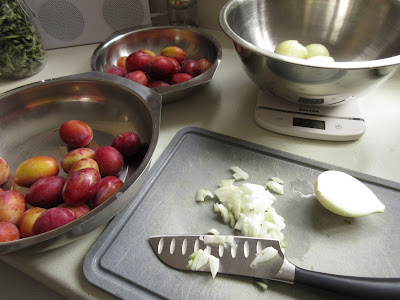One of the sights whenever I went to the local fruit and vegetable markets in Mauritius, were the lads cutting up the small local fresh pineapples. with machetes they cut off the finest of slithers to remove the coarse outer peel, then with smaller knives cut decorative channels removing the eyes. Have a look at my Pineapple Chutney Recipe where I explain the technique. We almost always bought the unpeeled ones to bring home.
When I was young almost every home used to make their own 'confitures' or compotes....Two of my mother's friends Aunty Frances and Aunty Phylis, both English ladies, would often come over with pots to share. Particularly memorable were jellies and jams made with Goyave de Chine or the small wild Strawberry Guavas that grew wild on the highland plateau. In season, our families used to go on Sundays for adventures, picnics and foraging. At home my very favourite was pawpaw and vanilla jam.
For the last few months, I have been making standard blackcurrant and strawberry jams for the year, but strangely missed out on apricot which is one of my favourites. Its when a friend brought me a bag of plums that I started to get my thinking hat on, leafing through my preserve and recipe books for a little inspiration.
I had read that Mes Confitures by Christine Ferber had inspired many lovers of jams. Just as a little present to myself, I sent off for my copy and have had it for less than a week. I've only dipped in here and there, and she describes a different approach compared to the 'traditional' British jam making techniques. As usual with my jams I like to try little twists, and look forward to reading this book, more or less from cover to cover.
There is no Pineapple and Passion Fruit recipe in Mes Confitures, but having a pineapple on the shelf just coming up to its best, and half a dozen passion fruits in the basket, I followed Ms Ferber's techniques and proportions.
I had also made some of the Green Apple Jelly which she uses as 'pectin stock' to add to fruit that has very little pectic. I've never successfully made good setting pineapple jam, and have make chutney with pineapple.
Here the fruit is draining, early this morning, after its overnight 'marinade' in its just boiled up state in the dissolved sugar. In releasing juices into the syrup, through osmotic dehydration, the chopped pineapple shrank.
The liquid is then boiled up to 105 C, then the fruit and apple pectin stock added...and more boiling until 105 C setting point is once more reached.
With only a small standard pineapple this is the yield. When trying something new I don't mind at all working on a small batch. I've just had a spoonful on my evening sheep's yogurt...definitely nicely pineappley with a good depth of passionfruit too. The jelly is very good, with pineapple and seeds nicely distributed. Its a little sweet so maybe my ratios were not quite right, or perhaps a little more lemon juice in my next attempt.
When I have perfected my proportions, I'll add my recipe, but of course, there may be more jams tried before then.
























